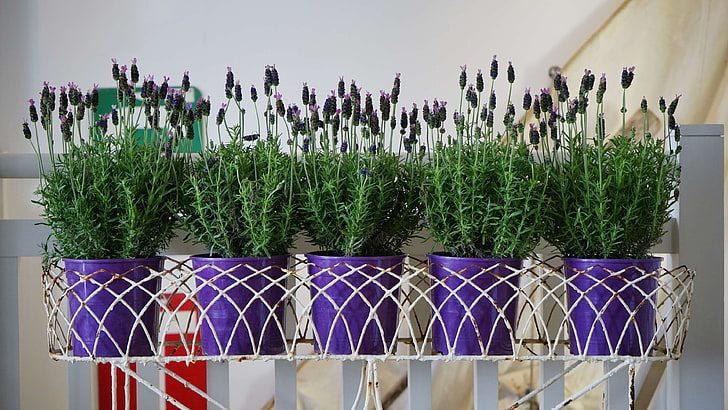The fragrant foliage can be used all year round and it is popular for making potpourri as a natural home perfume.

Lavender is an outdoor plant, but it can be grown indoors to make the most of its flowers and fragrant foliage.
This is particularly true of Lavandula stoechas, which is a spring-flowering lavender that produces the most beautiful of all lavender flowers. The bracts on top of each bloom resemble bunny ears or the open wings of a butterfly and a single bush throws up a myriad of flower spikes.
What better way to enjoy it than right under your nose? Rubbing its leaves as you walk past releases the calming lavender fragrance. It is a natural stress reliever.
Grown indoors stoechas needs bright light and can take some morning sun. That means you can put two or three plants in an indoor window box, of display the plants in a sunny living room, bedroom, or outdoor living area.
In warm, bright conditions, such as a patio or living area it may flower for up to three months.
Let the soil dry out moderately between watering. Cut stems back after they finish flowering to encourage a second flush of blooms.
Once the plant has finished flowering, shape the plant by lightly trimming it and plant in the garden in full sun in soil that drains well or into a larger outdoor container that receives morning sun and afternoon shade.

Stoechas lavender blooms in spring and needs a warm room indoors. Picture: Supplied
Because stoechas only flowers in spring, its use in the garden is a compact, bushy foliage plant, that should be kept neatly clipped, to prevent it from becoming woody.
Most varieties do not grow higher than 80cm, making it useful in mixed borders where grey-green foliage is needed for contrast. It can also be planted as a hedge around the vegetable garden as an insect-repelling herb for especially aphids and whitefly.
The fragrant foliage can be used all year round and it is popular for making potpourri as a natural home perfume. The potpourri can be used to make scented pillows for a peaceful sleep and sachets to keep cupboards, chest of drawers and closets fresh. The smell repels fish moths.
Did you know?
Stoechas is called Spanish lavender because it refers to the Stoechades islands in the Mediterranean sea. Plants grow naturally in Spain, Northern France, Algeria, and the Azores.
According to Margaret Roberts in her book The Essential Margaret Roberts, an infusion from the leaves was used as an antiseptic wash during the Middle Ages.
It was later found that Lavandula angustifolia was more effective, but for home use stoechas still works well as an antiseptic wash for cuts and insect bites.

Picture: iStock
Try this
Making a lavender pillow is a creative way to extend that fragrance, and this recipe by Margaret Roberts is achieved with only one pot of stoechas lavender.
She suggests making a small pillow of pure cotton, which is stuffed with foam chips or polyester fibre filler. Then make a small sachet 18cm by 12cm and fill with the following mixture:
- 1 cup dried lavender flowers
- 1 cup dried lavender leaves
- ½ cup cloves
- ½ cup chopped dried lemon peel
- Lavender potpourri oil
First mix the dried lemon peels and cloves and 1 tbsp of lavender oil. Keep sealed in a screw-top glass bottle for a week, giving it a daily shake. Then add the dried lavender flowers and leaves. Add a little more oil and keep sealed for another week. Shake daily.
Fill the sachet with this mixture and sew it closed. Put the sachet into the centre of the pillow amid the stuffing and sew the pillow closed.
For more news your way, download The Citizen’s app for iOS and Android.






